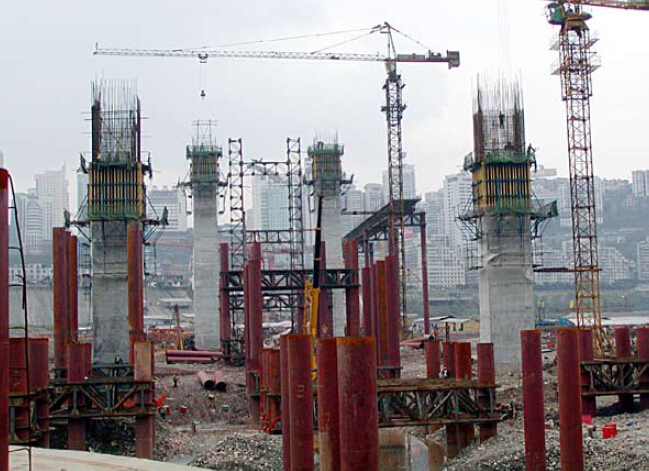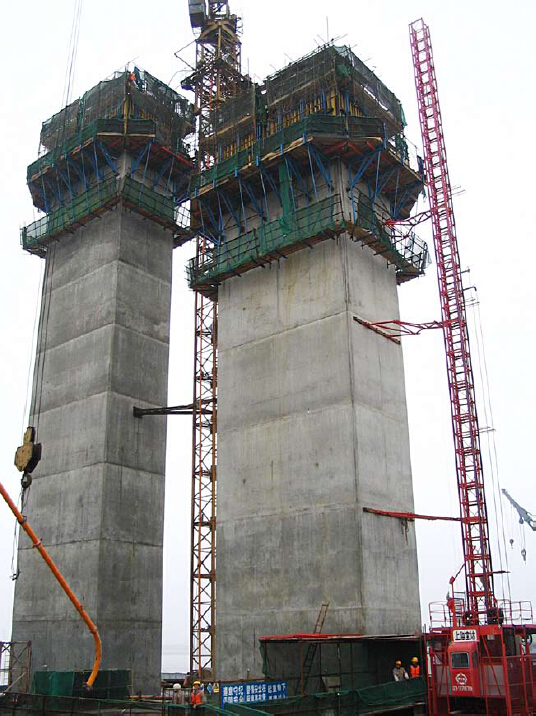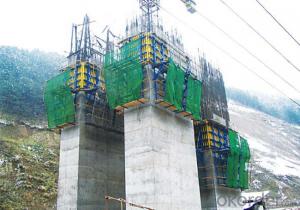Climbing Bracket CB240 for Formwork and Scaffolding systems
- Loading Port:
- Tianjin
- Payment Terms:
- TT OR LC
- Min Order Qty:
- 50 m²
- Supply Capability:
- 1000 m²/month
OKorder Service Pledge
OKorder Financial Service
You Might Also Like
Climbing Bracket CB240 & CB210
They are framework brackets for supporting large-area wall formwork.
Typical applications for the CB240&CB210 are pier and column/shear wall/core walll/ in the
building.
CB210 has smaller size than CB240, it will be cost effective in some condition.
Characteristics:
◆ High bearing capacity
The high loading capacity of the brackets allow very large scaffold units. This saves the number
anchor points required as well as reducing climbing times.
◆ Simple moving procedure by crane
Through the strong connection of formwork together with the climbing scaffold, both can be moved
as a single climbing unit by crane. Thus valuable time-savings can be achieved.
◆ Fast striking process without a crane
With the retrusive set, large formwork elements can also be retracted quickly and a minimum of
effort.
◆ Safe with work platform
The platforms have assembled firmly with bracket and will be climbing together, without scaffolding
but can work safely in spite of your high location.


- Q:What are the different edge protection systems available for steel formwork?
- Steel formwork offers various options for edge protection systems, each devised with the intention of safeguarding construction workers and providing support. Guardrails are a common choice, typically made of steel or aluminum, which are installed along the formwork edges to prevent falls. These guardrails are easily adjustable in height and can be effortlessly installed and removed as necessary. Another edge protection system involves the use of safety nets. These nets are positioned beneath the formwork, acting as a barrier to catch any falling workers or materials. Manufactured from durable synthetic fibers, safety nets are engineered to absorb the impact of a fall, minimizing the risk of injury. Toe boards are an additional type of edge protection system. These boards are installed along the lower edge of the formwork, preventing tools, equipment, or materials from falling and causing harm. Typically crafted from wood or metal, toe boards are securely fastened to the formwork. Moreover, comprehensive edge protection solutions are available, combining guardrails, safety nets, and toe boards. These holistic systems offer multiple layers of protection to ensure worker safety at the construction site. In conclusion, the range of edge protection systems offered for steel formwork serves to prevent falls, safeguard workers, and establish a secure working environment. It is crucial for construction companies and workers to meticulously evaluate the specific requirements of their project and select the appropriate edge protection system to fulfill their needs.
- Q:Can steel formwork be used for both vertical and horizontal concrete elements?
- Both vertical and horizontal concrete elements can utilize steel formwork. Steel formwork is extremely versatile and can be easily assembled and disassembled, making it suitable for a wide range of concrete structures. It offers a robust and long-lasting support system for pouring concrete, ensuring the desired shape and finish of the concrete element. Steel formwork can be customized and modified to meet the specific needs of any project, whether it be for walls, columns, beams, slabs, or any other concrete component. Its ability to withstand high pressure and heavy loads makes it an excellent choice for both vertical and horizontal applications. Furthermore, steel formwork can be used multiple times, making it a cost-effective solution for construction projects.
- Q:Are there any specific considerations for using steel formwork in areas with limited power supply?
- Yes, there are several specific considerations for using steel formwork in areas with limited power supply. Firstly, since steel formwork requires power tools for installation and removal, alternative methods such as manual labor or non-powered equipment may need to be employed. Additionally, the limited power supply may affect the availability of electricity for welding, which is often required for steel formwork assembly. Therefore, alternative joining methods such as bolting or mechanical fastening may need to be explored. Finally, the transportation and storage of steel formwork components in areas with limited power supply may require additional planning to ensure their accessibility and protection.
- Q:What are the different types of steel formwork available?
- There are several types of steel formwork available in the construction industry, each with its own unique features and advantages. Some of the most common types include: 1. Modular steel formwork: This type of formwork consists of prefabricated steel panels that can be assembled and disassembled easily. It is customizable and can be used for various shapes and sizes of concrete structures. 2. Tunnel formwork: As the name suggests, tunnel formwork is used for constructing tunnels and underground structures. It is made of steel plates and is designed to withstand high pressure and provide a smooth finish to the concrete. 3. Climbing formwork: This type of formwork is used for tall structures like skyscrapers. It is designed to be lifted and moved vertically as the construction progresses. Climbing formwork provides safety and efficiency while constructing multi-story buildings. 4. Steel soldier formwork: This is a versatile and cost-effective type of formwork that is commonly used for walls and columns. It is made of steel beams and soldiers and can be easily adjusted to different heights and widths. 5. Steel frame formwork: This type of formwork is made of steel frames with plywood or metal panels attached to it. It is lightweight, easy to handle, and provides a smooth finish to the concrete. 6. Steel table formwork: This is a type of formwork that is used for large horizontal slabs. It consists of steel tables that are supported by props or scaffolding. Steel table formwork is quick to assemble and dismantle, making it ideal for projects with tight timelines. These are just a few examples of the different types of steel formwork available. The choice of formwork depends on the specific requirements of the construction project, such as the type of structure, load-bearing capacity, and desired finish.
- Q:How does steel formwork handle different concrete surface protection methods?
- Steel formwork is a versatile and durable option for constructing concrete structures, and it can easily handle different concrete surface protection methods. The formwork itself is typically made of steel plates or frames that provide a strong and rigid support structure for the wet concrete. When it comes to protecting the concrete surface, there are various methods that can be employed, such as applying surface coatings, using form release agents, or using various types of form liners. Steel formwork can easily accommodate these methods and ensure their effectiveness. For instance, if a surface coating is being applied to protect the concrete, steel formwork can provide a smooth and uniform surface that allows for even and consistent application of the coating. The steel formwork is resistant to damage from the coating materials and can withstand the pressure and weight of the wet concrete while the coating cures. Similarly, when using form release agents, steel formwork can ensure proper adhesion and prevent any sticking or bonding between the concrete and the formwork. The smooth and non-porous surface of steel formwork allows for easy application and removal of the form release agents, ensuring a clean and protected concrete surface. Furthermore, steel formwork can accommodate the use of various types of form liners, which are used to create decorative or textured finishes on the concrete surface. The form liners can be easily attached to the steel formwork to create the desired texture or pattern, and the sturdy nature of steel ensures that the form liners remain securely in place during the pouring and curing process. In summary, steel formwork is highly compatible with different concrete surface protection methods. Its strength, durability, and versatility allow for easy application of coatings, form release agents, and form liners, ensuring a well-protected and aesthetically pleasing concrete surface.
- Q:How does steel formwork handle concrete bleeding and segregation?
- Steel formwork helps to handle concrete bleeding and segregation in several ways. Firstly, the smooth and impermeable surface of steel formwork prevents excessive bleeding of water from the concrete mix. This helps in maintaining the desired water-cement ratio, which is essential for the strength and durability of the concrete. Secondly, steel formwork provides a rigid structure that holds the concrete in place, reducing the chances of segregation. It prevents the coarse aggregates from settling at the bottom, ensuring a uniform distribution of aggregates and cement throughout the concrete. Additionally, steel formwork systems are designed with proper reinforcement and bracing, which further minimizes the risk of concrete segregation during the pouring and curing process. The rigid construction of steel formwork also helps in preventing any movement or displacement of the concrete, which can lead to segregation. Overall, steel formwork is an effective solution for handling concrete bleeding and segregation by providing a stable and impermeable surface, proper reinforcement, and preventing any movement or displacement of the concrete.
- Q:How does steel formwork affect the overall dimensional stability of a structure?
- Steel formwork can significantly impact the overall dimensional stability of a structure in a positive manner. Due to its inherent strength and rigidity, steel formwork provides excellent support during the construction process, ensuring accurate and precise concrete placement. This results in a structure with improved dimensional stability as the steel formwork helps to maintain the designed shape and dimensions. The use of steel formwork offers several advantages that contribute to the overall dimensional stability. Firstly, steel is known for its high strength-to-weight ratio, which allows for the creation of sturdy and durable formwork systems. This strength translates into better resistance against deformation, preventing any shifts or movements in the formwork during concrete pouring. As a result, the final structure is less likely to experience dimensional changes, ensuring the desired shape and dimensions are maintained. Additionally, steel formwork provides superior dimensional accuracy compared to other formwork materials. Steel plates or panels used in the formwork can be manufactured with high precision, resulting in consistent dimensions and smooth surfaces. This precision eliminates any inconsistencies or irregularities that may arise from using traditional formwork materials like wood or plywood, further enhancing the overall dimensional stability of the structure. Moreover, steel formwork is highly resistant to moisture, humidity, and temperature variations, which can often lead to dimensional changes in other materials. Steel's resistance to these factors ensures that the formwork remains stable and retains its original shape, even under challenging environmental conditions. This stability extends to the concrete poured within the formwork, as the steel helps to minimize shrinkage and expansion, thereby reducing the risk of cracking or warping in the structure. In conclusion, steel formwork plays a crucial role in maintaining the overall dimensional stability of a structure. Its strength, precision, and resistance to environmental factors ensure that the formwork remains intact and supports the concrete placement accurately. By providing a reliable and robust framework, steel formwork allows for the creation of structures with enhanced dimensional stability, resulting in a more durable and long-lasting final product.
- Q:How does steel formwork handle different concrete surface coloring techniques?
- Steel formwork is a versatile and durable material that effectively handles various concrete surface coloring techniques. The main advantage of using steel formwork lies in its smooth and non-porous surface, which guarantees even application of concrete coloring techniques and desired results. When it comes to concrete surface coloring techniques like staining, stamping, or integral coloring, steel formwork offers a stable and consistent foundation for these processes. The seamless surface of steel formwork allows for uniform and attractive distribution of colorants or pigments, ensuring a cohesive appearance of the final concrete surface. Moreover, the strength and rigidity of steel formwork make it suitable for different concrete surface coloring techniques. Whether it involves stamping, which necessitates the pressing of textured patterns onto the concrete surface, or staining, which requires precise application of colorants, steel formwork provides the necessary support and stability to execute these techniques accurately. Furthermore, the durability of steel formwork renders it resistant to damage during the coloring process. Concrete surface coloring techniques often involve the use of chemicals, dyes, or stains that can potentially harm weaker or less resistant formwork materials. However, the robustness of steel formwork allows it to withstand the harsh chemicals and coloring agents without compromising its structural integrity. In conclusion, steel formwork is an excellent choice for handling diverse concrete surface coloring techniques. Its smooth and non-porous surface ensures the even distribution of colorants, while its strength and rigidity provide the necessary support for techniques such as stamping or staining. Additionally, the durability of steel formwork protects it from damage caused by chemicals or coloring agents, ensuring a successful and visually pleasing outcome.
- Q:What are the different types of formwork corners used in steel formwork systems?
- There are typically three types of formwork corners used in steel formwork systems: external corners, internal corners, and chamfer corners. External corners are used to create sharp outside corners in the concrete structure. Internal corners are used to create sharp inside corners in the concrete structure. Chamfer corners are used to create beveled edges or rounded corners in the concrete structure. These different types of corners allow for flexibility in the design of the concrete structure and ensure a smooth and precise finish.
- Q:Can steel formwork be used for fire-resistant concrete structures?
- Fire-resistant concrete structures can indeed utilize steel formwork. Steel possesses exceptional strength and heat resistance, rendering it an optimal choice for constructing formwork in such cases. Furthermore, steel formwork presents several benefits, including longevity, reusability, and effortless assembly and disassembly. By offering essential support and containment during the pouring and curing processes, it guarantees the integrity and safety of the structure in the event of a fire. Nevertheless, it is crucial to acknowledge that the fire resistance of the concrete itself is contingent upon factors like mix design, aggregate selection, and thickness, rather than relying solely on the formwork material.
1. Manufacturer Overview |
|
|---|---|
| Location | |
| Year Established | |
| Annual Output Value | |
| Main Markets | |
| Company Certifications | |
2. Manufacturer Certificates |
|
|---|---|
| a) Certification Name | |
| Range | |
| Reference | |
| Validity Period | |
3. Manufacturer Capability |
|
|---|---|
| a)Trade Capacity | |
| Nearest Port | |
| Export Percentage | |
| No.of Employees in Trade Department | |
| Language Spoken: | |
| b)Factory Information | |
| Factory Size: | |
| No. of Production Lines | |
| Contract Manufacturing | |
| Product Price Range | |
Send your message to us
Climbing Bracket CB240 for Formwork and Scaffolding systems
- Loading Port:
- Tianjin
- Payment Terms:
- TT OR LC
- Min Order Qty:
- 50 m²
- Supply Capability:
- 1000 m²/month
OKorder Service Pledge
OKorder Financial Service
Similar products
New products
Hot products
























